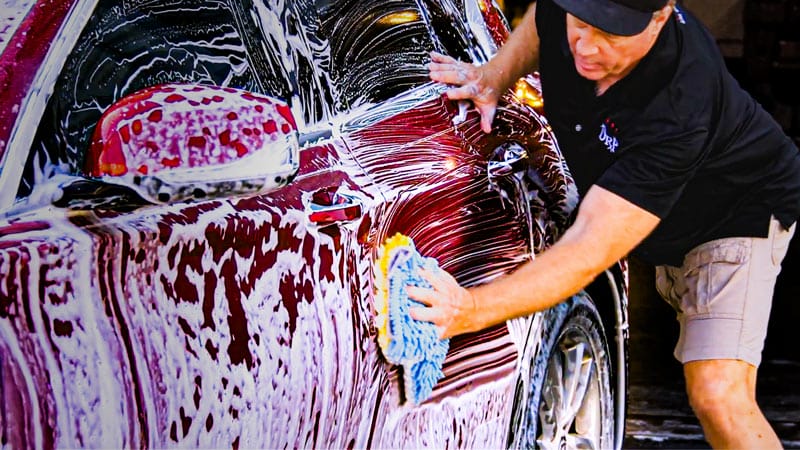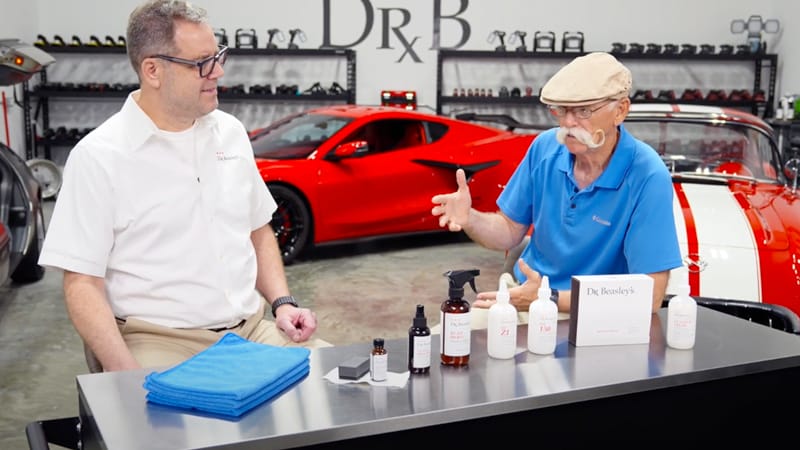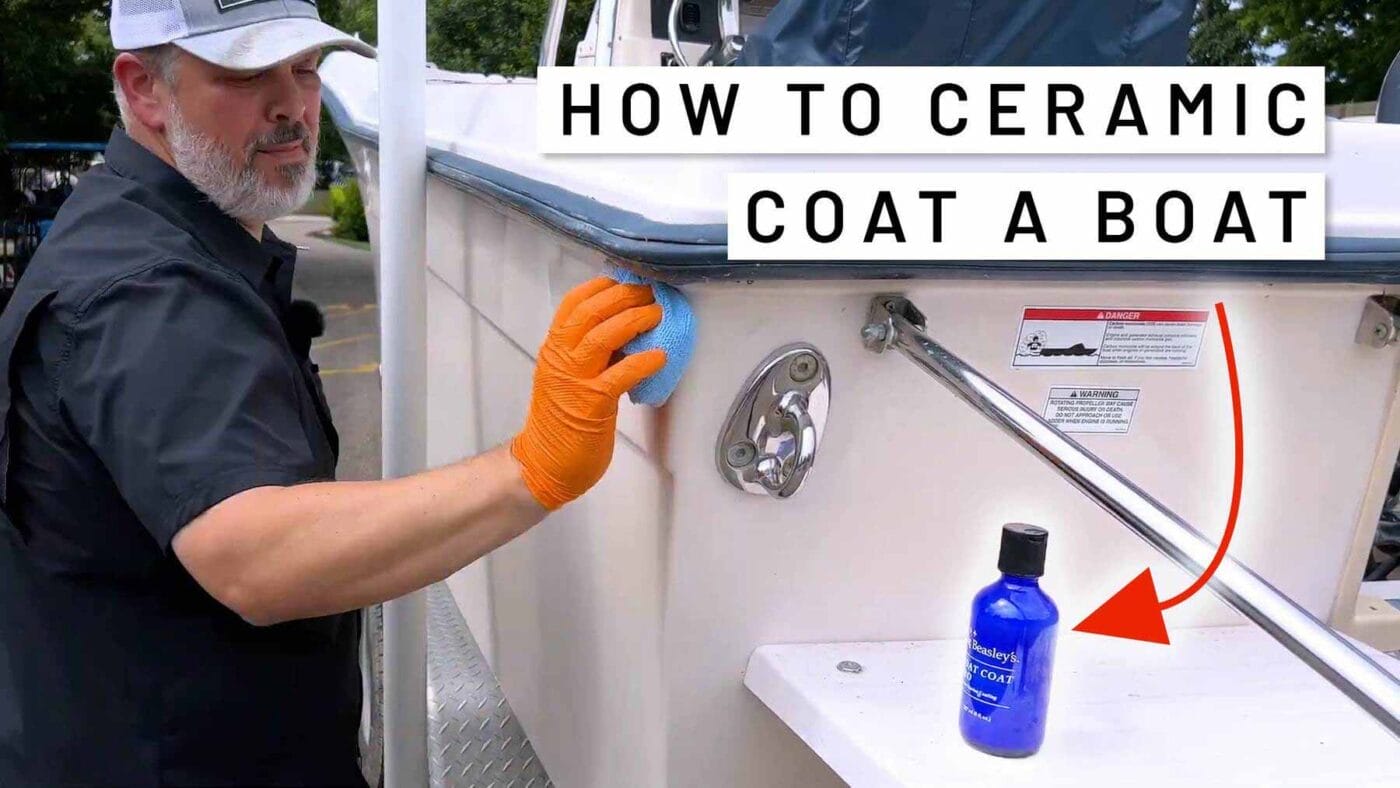Last Updated September 23, 2022
Last Updated September 23, 2022

The following text is a transcript of the above video. It has been edited for clarity.
Welcome back everybody! I am Dr. Beasley’s Director of Success Chris Racana here in beautiful Walworth County, Wisconsin with my Grady White. The biggest 20 footer you’ll ever see, I love this boat. We have now debadged the port side. And so now we’re here to start the actual prep process for coatings.
The endgame here is Boat Coat Pro, but we obviously have to prep it. Now, as boat owners, you know, myself included for many years: we’re loyal, tried and true to carnauba. If we’re going to go to this new technology of ceramic coating of nanotechnology, that means we have to remove all of that old technology off of here because any carnauba that is left on this hull is going to hinder the adhesion of Boat Coat Pro. There’s one or two ways we can do this: We can do it chemically or we can do it mechanically. The ideal way is to do it mechanically.
Prepping for Marine Ceramic Coating
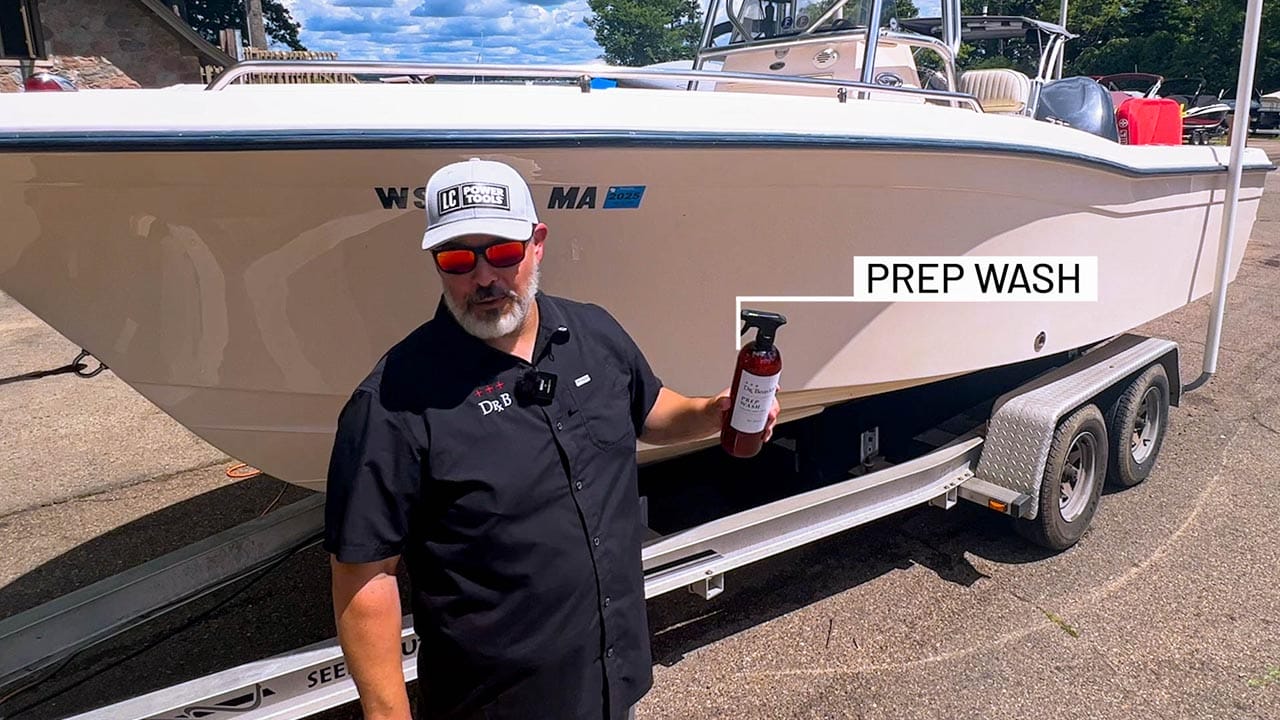
So, we’re going to first prep, and I’m going to be using Prep Wash. Again, yet another use for Prep Wash. I don’t feel like washing down this whole boat. It doesn’t really need it, it’s dusty but that’s about it. It’s been sitting on the lift for the last couple months. I did correct this last year, so I don’t really want to get that deep into it. It’s far from perfect, but I did buy this boat used. I’m just trying to keep it nice, keep it looking well, and just keep it protected so my family and I have many more years of enjoyment- using good ol’ Pura Vida, as we have named her.
The beautiful thing about Prep Wash: It’s 100% inorganic so this way, anything that may be left behind is not going to hinder the adhesion of a ceramic coating. Plus, it smells nice too! In this case, I don’t feel like washing down my whole boat. It’s not caked full of mud, dead bugs, and bird poop and all this kind of stuff where I would need the foaming action of a traditional wash.
Let’s go ahead and get to it: Simple spray and wipe product, you have a fairly long hang time with it. We’re going to go ahead and finish cleaning this gel coat up with our HDO Blue Pad. You know, again, for the age of this boat and considering how I use it. I only do this about once a year. Basically, what I’m doing here is just making sure I’m cleaning all that stuff off. I’m not really looking to correct anything necessarily. Here’s my process: Four passes with NSP 95 on the HDO Blue Pad. We’re good to go. You’ll notice when I’m working in these smaller areas, I’m not reloading all the time, and when I am reloading, it’s not a lot.
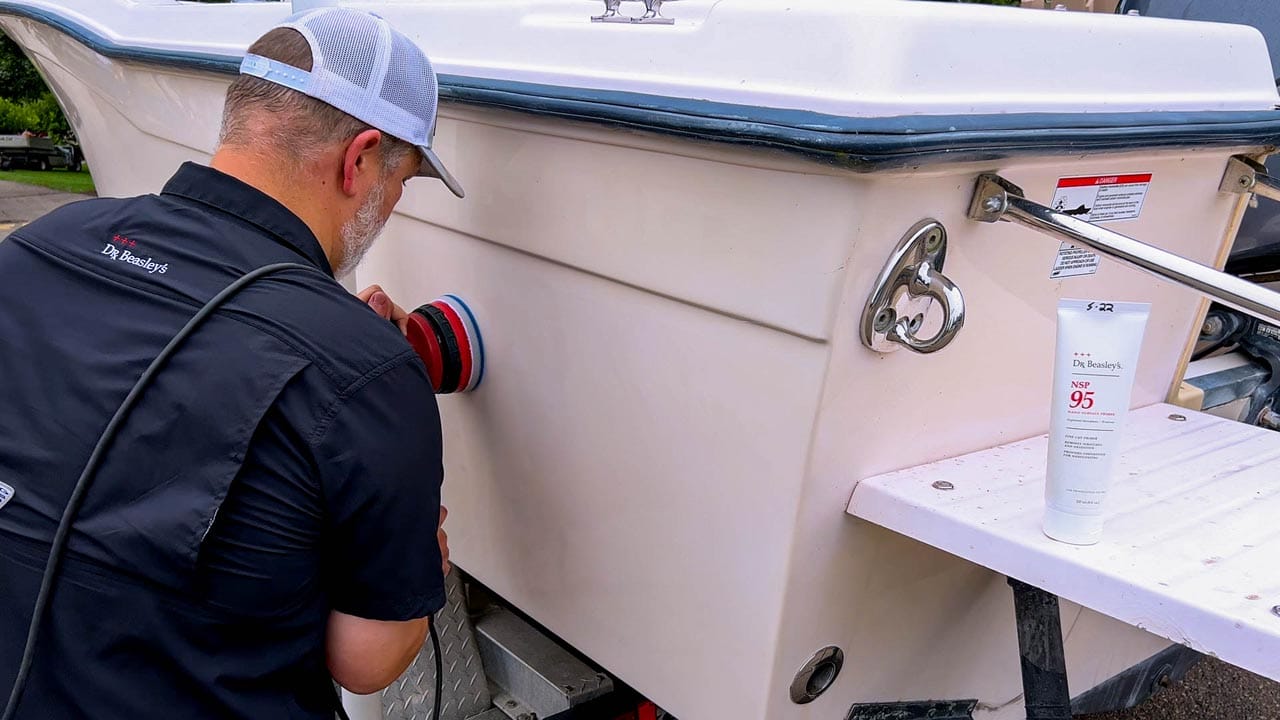
At this point, I’ve done the whole side of the hull. Remember, the beautiful thing that we have right here is the product sits on top of the pad, so that way we’re keeping it between the pad and the gel coat. So, all this product now that we have sitting on top of this pad, I know I have enough in here that I can do these little areas without having to add more product.
All right. Polishing step is nearly complete. Now again, folks, let’s keep something in mind here. This boat has 400 hours on it, I think just over if I’m not mistaken. 2007 is the year. So I’m never expecting this hull to be perfect. It wasn’t perfect when I bought it, and that’s why I like the boat is because it is perfectly imperfect.
All right, everybody. We’ve done all our preparation work, and now we can finally talk about Boat Coat Pro.
Applying Protection to Gel Coat
So, I’m really excited to get into the marine industry with some nanotechnology based protection. This is a really wonderful product. Also marine life safe, which I like to stress a lot. I’m a fisherman, obviously, judging by the boat that I have behind me, when I go out fishing, I prefer the fish to have the appropriate number of fins and gills. So I would rather not introduce things that are going to harm marine life.
One of the other advantages of this product is it’s going to give you much easier maintenance. So whether you keep it on a lift, if you trailer it – your end of trip, end of day washing procedure is going to be tremendously easier and a lot less effort. Of course, it’s also going to be contaminant resistant. So this is when we talk about antifouling. Now, granted, if you put your boat on a buoy and it just sits there all season long and you hardly use it, at a certain point, you’re going to end up with all sorts of zebra mussels and other sorts of marine life fuzing themselves to your gel coat. But, in the case that you are actually using and maintaining your boat, you know this is going to help ward off that kind of contamination.
In addition to making your maintenance easier and generally keeping the boat looking well, let’s talk about the technology that we’re employing here. Unlike an automotive clear coat, gel coats are porous. But you want to talk about peaks and valleys, which we can relate to at Dr. Beasley’s because we know a thing or two about bonding to structures that have peaks and valleys similar to, I don’t know, let’s say matte paint on a car.
Here we’re talking similar technology, but in the fact that what we’re actually doing is we’re providing that layer of nanotechnology that’s going to become part of that gel coat and help seal that gel coat so we can keep any of those contaminants or or any of that marine life from getting into those little nooks and crannies in this gel coat.
When it comes to application, we do give you an eight ounce glass bottle. How far is that going to go? That’s always the million dollar question. And of course, that’s going to depend on the size of the boat. “Oh, I got a 20 foot boat.” A 20 foot boat can mean a lot of different things. Is it a bass boat? How much draft does it have? Not a lot of fiberglass above the waterline? Or is it something like this where we’ve got a lot of fiberglass from the waterline to the bowline? So that’s going to affect how much coating we’re going to need.
Also, how thirsty is it? Some gel coats are going to be more thirsty than others are. I expect to be able to coat this entire boat with about half this bottle, probably less than that in all honesty if we want to be a little bit more efficient with it.
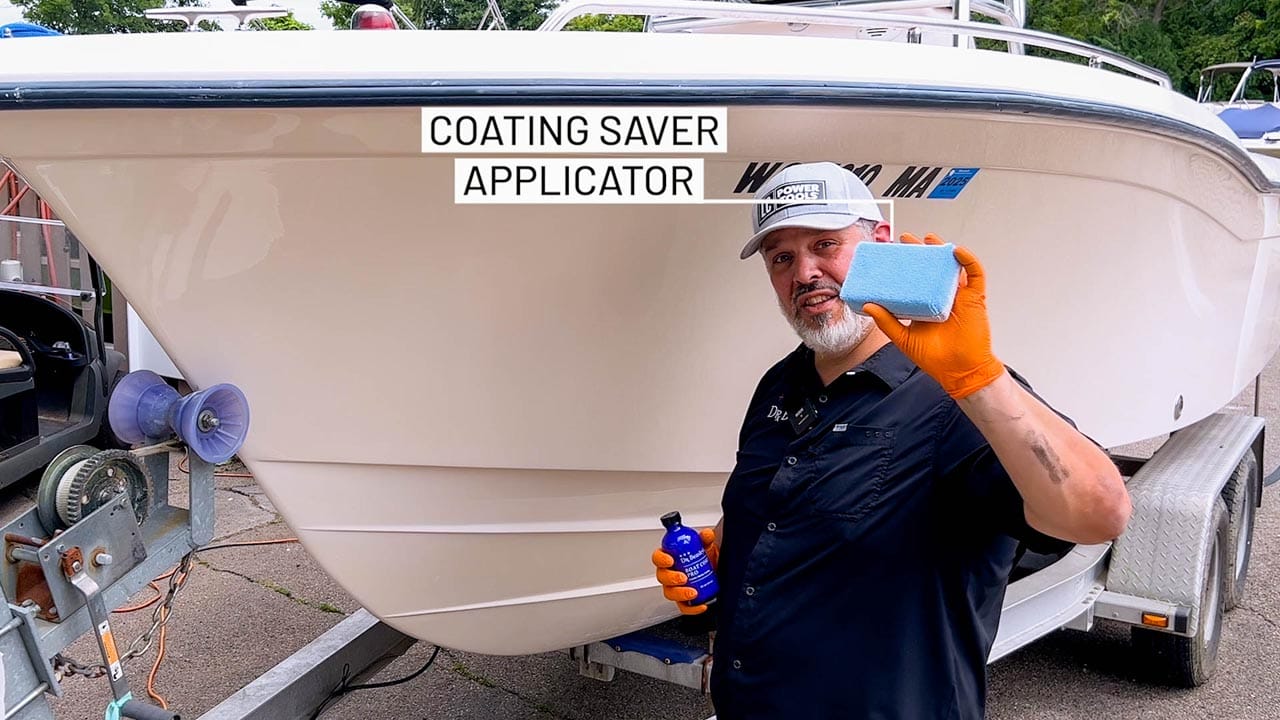
As far as the application we are carrying, the applicator, the Coating Saver. The cool thing is actually if you take a cross-section of these, you’ll see that they’re actually lined on the inside. So this way, when I put the coating onto this, it’s just soaking in just to the microfiber exterior. It’s not going to soak into the foam that’s inside the sponge, so we’re not going to waste any product.
So of course, like anything: Shake well. I’m going to prime the pad: Two, three, four, five, six, seven. I want to be fairly generous with it. If you want to go Mr. Miyagi style or you want to go crosshatch, whatever you want to do, go for it. It’s all just about making sure you have total coverage. Now, it is a self-leveling coating, so I’m not worried about leveling necessarily and it’s an instant bonding coating. So it’ll start to be effective as soon as we put it to the substrate.
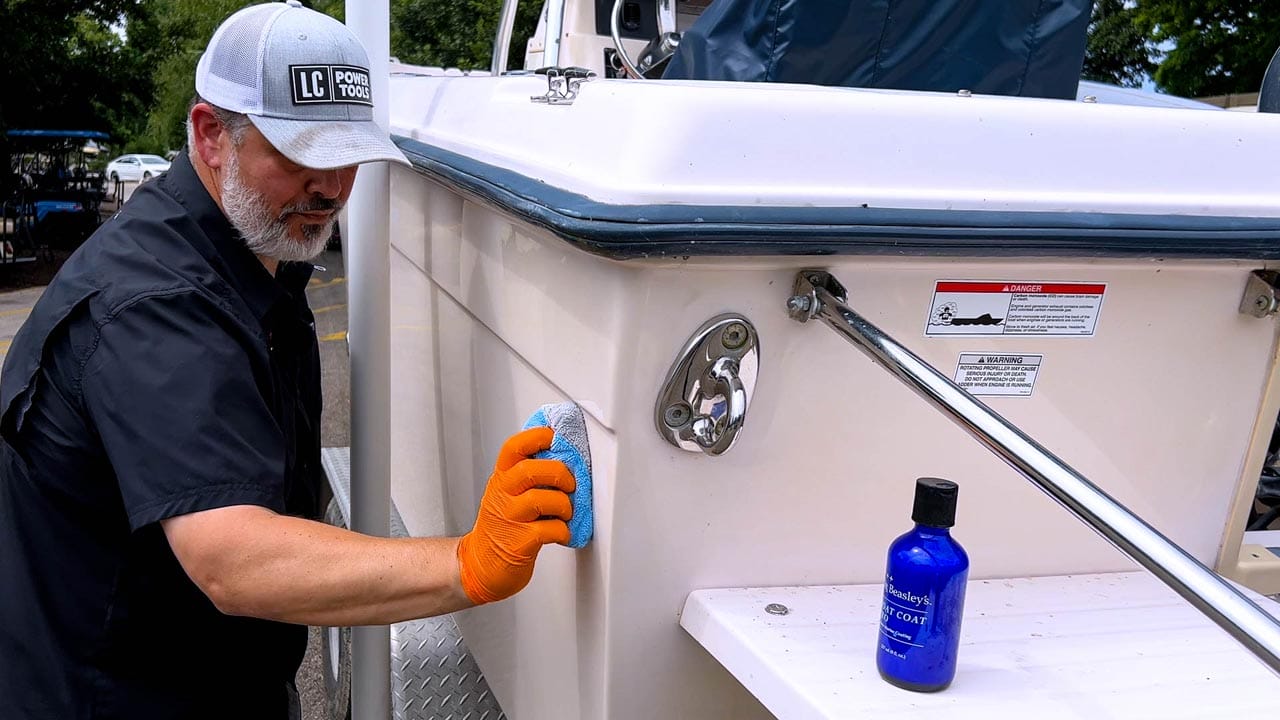
However, like any of our other coatings, we’re going to want to follow the same guidelines of one hour undisturbed, 24 to 48 hours dry, and two weeks, no washing. Now, of course, that usually has to do more with automotive in mind at that point. It’s always hard to judge. Two weeks, no washing, not hard on a boat, but, the idea is like, the loaf of bread is just not fully baked. After that first 24 hours, we got a nice crust. So it’s not a big deal to get some rain on it etc. But we haven’t gotten to the point where it’s all the way through where it can take friction of having someone put that kind of pressure and friction on it.
So I would recommend keeping your boat out of the water for 24 hours. You have an extremely long working time. So, depending on your environment, you’re going to be able to see you’re gonna have long areas. Now if you want to push it further and do larger blocks of fiberglass, that’s not a problem. You can and I’m going to demonstrate shortly how far you can push this product. But if you do come into a situation where you have let it dry up on you and you have found yourself with a high spot that is easily solved, we take a little bit of a product and we re-emulsify the area. If I have dried coating here, especially if I catch it within a reasonable amount of time, I can go ahead and just re emulsify the area, reactivate the product and go ahead and buff it off with the microfiber.
Well immediately I can feel even just on buff off how much more slick that is. Really nice, easy take off. On the initial take off, it’s a little bit grabby because the surface is wet. But after that initial wipe, the kind of flip and the buff, very nice, very slick, very easy, minimal effort, not breaking too much of a sweat here.
I like to do the transom last. That’s the way I’ve always done it. But hey, to each their own – free will and all that kind of stuff. So let’s get to it. At this point, I really don’t need to add a lot because this is pretty well saturated here.
Products Used to Apply Boat Coat Pro
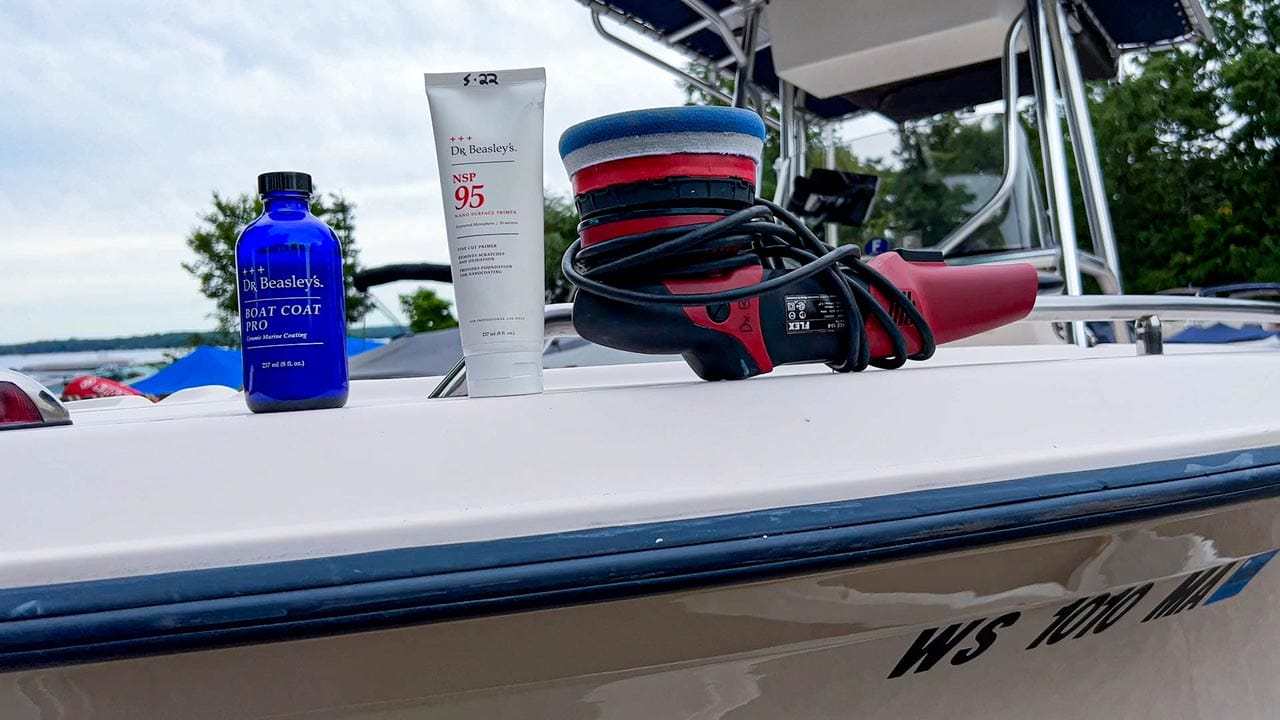
What was the prescription today for my 208 Grady White from 2007, nearly 15 years old, folks? It was NSP 95. That is our fine cut Nano Surface Primer along with my flex super beast HDO Blue Pad. And then finally our protection step was our Boat Coat Pro and through the application on this 20 foot boat we did rub rail to the waterline.
We used just over two ounces of product. It was a super efficient application and time wise I was able to move through this rather quickly. So again, we hope you enjoy this. We hope you enjoy Boat Coat Pro. Make your own video, put it out there and tag us in it. Let’s see what else you guys are doing with Boat Coat Pro and our Nano Surface Primers when it comes to marine, I think it’s an underutilized tool for marine. We know how fantastic it is on contemporary automotive paint, but I’m here to get the word out. Let’s preach people, NSPs on gel coats! Let’s get some gloss sauce on these boats that are in this lake! Safe boating!

